Standing all day can take a serious toll on your feet—especially for nurses, retail workers, and professionals who spend hours on their feet. One of the most common and painful problems?
Blisters. These small yet stubborn irritations can make every step feel like a challenge and, if ignored, lead to infections or longer recovery times.
The good news is that with the right socks, shoes, and foot care habits, you can easily prevent blisters from standing in the first place. In this guide, we’ll explore how to prevent blisters from standing all day, keep your feet healthy, and stay comfortable during long shifts.
What Causes Blisters from Standing All Day?
Blisters might seem like a small inconvenience, but for nurses and anyone on their feet all day, they can quickly turn into a painful problem that makes every step uncomfortable. By understanding the root causes, you can take smart steps to prevent them before they even form.
1. Friction from Poor-Fitting Shoes
One of the biggest culprits is friction. When your shoes are too tight, too loose, or simply not shaped for your feet, they rub against the skin with each step. This constant rubbing creates heat, which causes the top layer of your skin to separate and fluid to collect underneath — that’s your blister. Shoes that pinch your toes or slide at the heel are especially risky.
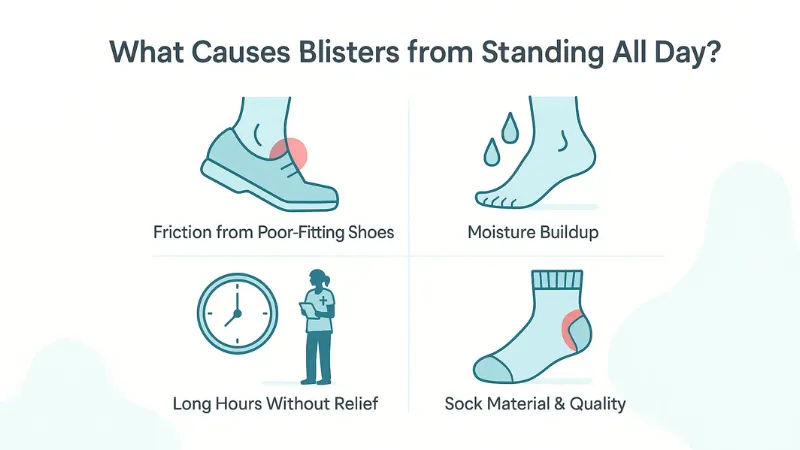
2. Moisture Buildup in Your Shoes
Sweat is another major factor. When your feet get damp, the skin becomes softer and more fragile, making it much easier for friction to damage it. That’s why people who stand for hours — especially in warm environments — are more likely to get blisters. Without proper moisture control, even the best shoes can’t fully protect your feet.
3. Long Hours Without Relief
If you’re a nurse or healthcare worker, you already know that sitting breaks can be rare. Standing or walking for long stretches without rest creates constant pressure on specific spots of your feet, which leads to hot spots and eventually blisters. Over time, even small pressure points can become major problems.
4. Sock Material and Quality
Your socks act as the first line of defense between your foot and your shoe. Thin, rough, or poorly made socks can rub against your skin instead of protecting it, especially if they bunch up or slip during movement. Materials that don’t wick away moisture can make the blister problem even worse.
Bottom line: Blisters from standing all day aren’t just bad luck — they’re the result of friction, moisture, pressure, and poor sock choice. Understanding these triggers makes it easier to choose the right prevention strategies.
How to Prevent Blisters from Standing All Day- Expert Tips for Nurses
1. Choosing the Right Socks
When it comes to preventing blisters from standing all day, your socks are just as important as your shoes — maybe even more. The best socks for standing all day act as a protective barrier between your foot and your shoe, reducing friction, controlling moisture, and supporting circulation. Choosing the wrong pair can leave your feet sweaty, sore, and more prone to blisters, while the right pair can keep you comfortable through a 12-hour shift.
Cushioned, Seamless Designs
Cushioning provides an extra layer of protection against friction, especially in high-pressure areas like the heels and balls of your feet. A seamless toe design is essential — even a tiny seam can create a rubbing point that turns into a blister over time. For nurses and healthcare workers constantly on the move, that extra padding can make all the difference between finishing your shift strong and limping by lunchtime.
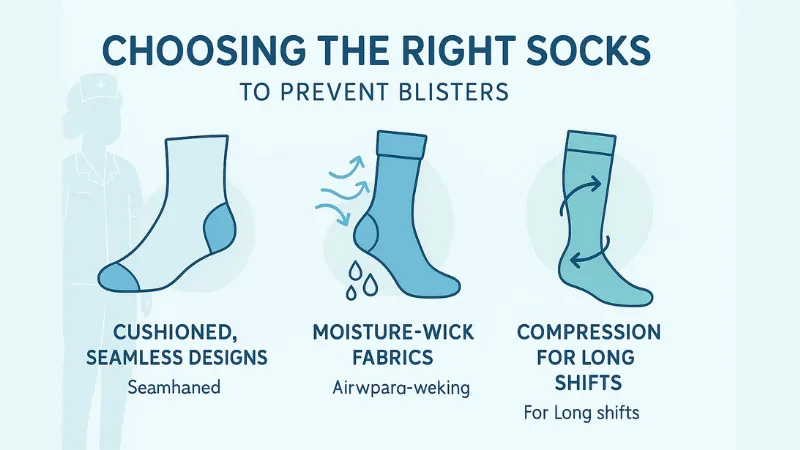
Moisture-Wicking Fabrics
Moisture is a blister’s best friend, which is why choosing socks made from moisture-wicking materials is crucial. Merino wool is a natural choice — it’s soft, breathable, and excellent at regulating temperature. High-quality synthetic blends, like polyester-spandex mixes, also do a great job of pulling sweat away from the skin so your feet stay dry. Avoid 100% cotton socks, as they tend to trap moisture and stay damp for longer.
Compression Socks for Long Shifts
Compression socks aren’t just for runners — they’re a game-changer for nurses and other professionals on their feet all day. By improving circulation and reducing swelling, they help minimize fatigue and keep your feet feeling supported. Some compression socks also incorporate moisture-wicking fibers and light padding, giving you both comfort and health benefits in one package.
Pro tip: If you rotate between several pairs of high-quality, moisture-wicking socks, you’ll extend their lifespan and keep your feet consistently protected.
2. Managing Moisture: How to Stop Feet from Sweating in Shoes
Sweaty feet don’t just feel uncomfortable — they create the perfect environment for blisters. Excess moisture softens your skin, making it more vulnerable to friction and irritation. If you’re wondering how to stop feet from sweating in shoes, the key is to combine smart product choices with breathable footwear habits.
Use Foot Powders or Antiperspirant Sprays
Foot powders work by absorbing excess moisture, while antiperspirant sprays help regulate sweat production. Look for products that also include antibacterial ingredients to reduce odor. Apply them before putting on socks, especially on high-sweat areas like the balls of your feet and between the toes.
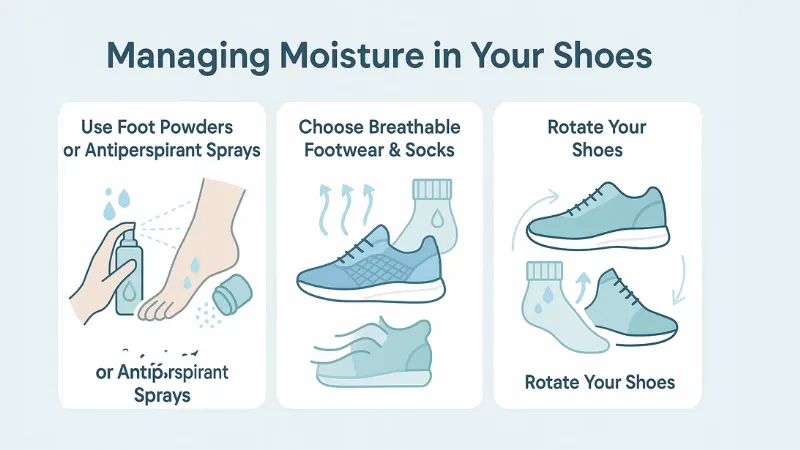
Choose Breathable Footwear and Socks
Your shoes should allow air to circulate, preventing heat and moisture from building up. Mesh panels, perforated leather, or lightweight synthetic uppers can all improve ventilation. Pair them with moisture-wicking socks — such as merino wool or technical synthetic blends — to draw sweat away from the skin. Avoid plastic or vinyl shoes, which trap heat and moisture.
Rotate Your Shoes
Wearing the same pair of shoes day after day means they never have a chance to fully dry out. Rotating between at least two pairs allows each to air out and maintain its shape, reducing the risk of damp, bacteria-friendly environments.
Pro tip: If your shoes still feel damp after a shift, remove the insoles and stuff them with newspaper or use a shoe dryer to speed up the drying process
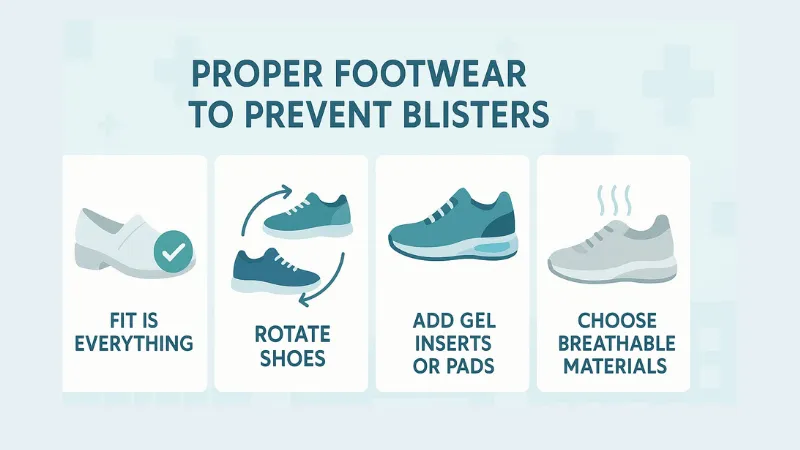
3. Wear Proper Footwear to Prevent Blisters
When it comes to preventing blisters from standing all day, your shoes are more than just part of your uniform — they’re your daily protection against pain. The right pair can significantly reduce friction, improve comfort, and keep your feet healthy during long shifts.
Fit Is Everything
Shoes should support your feet snugly without pinching or squeezing. A loose fit allows your foot to slide around, creating friction, while a too-tight fit increases pressure on certain areas. That’s why choosing the right one is important. Always try shoes on later in the day when your feet are slightly swollen, as this mimics real work conditions.
But sometimes it’s really hard to find the right shoes. Don’t worry, we’ve listed the best shoes for nurses for you so that you don’t get overwhelmed searching for a good one.
Rotate Shoes
Wearing the same pair every day can cause them to develop “hot spots” where the insole or upper wears down unevenly, leading to friction. Having two or three pairs to rotate gives each set time to dry out and return to its original shape, extending their lifespan and reducing blister risk. You should keep your shoes clean so that they are always available when you need them
Add Gel Inserts or Pads
Gel inserts, cushioned insoles, or blister prevention pads provide extra cushioning and help reduce rubbing in high-friction areas. They’re especially helpful if your shoes are supportive but slightly firm.
Choose Quality, Breathable Materials
Shoes made from leather, mesh, or high-quality synthetic blends mold naturally to your foot shape over time while allowing airflow. This helps regulate moisture levels, keeping your feet cooler and drier — two crucial factors in blister prevention.
Pro tip: Before committing to a new pair, wear them around the house with your work socks for a few hours. This “mini break-in” period can reveal any pressure points before your first 12-hour shift.
4. Follow a Proper Foot Care Routine for Blister Prevention
A proper foot care routine is just as important as choosing the right shoes or socks — especially for nurses who spend hours on their feet. By taking a few minutes each day to care for your feet, you can prevent blisters from standing, reduce fatigue, and protect your long-term foot health.
Clean and Dry Your Feet Thoroughly
At the end of each shift, wash your feet with mild soap and warm water to remove sweat and bacteria. Pay extra attention to the spaces between your toes, as trapped moisture can increase friction and lead to blisters. Always dry completely before putting on socks or lotion.
Moisturize — But at the Right Time
Hydrated skin is less likely to crack and more resilient against rubbing. Apply a nourishing foot cream or lotion at night so it has time to absorb while you sleep. Avoid heavy moisturizing right before work, as overly soft skin can make blistering more likely.
Check for Hot Spots Early
If you notice a warm or tender area on your foot during a shift, address it immediately. Apply a protective pad, moleskin, or gel cushion to reduce friction before it becomes a blister.
Build This Into Your Daily Routine
For nurses, these nurse foot care tips aren’t just about preventing blisters — they’re about how to take care of your feet as a nurse for the long haul. Making foot care a consistent habit helps you stay comfortable, avoid painful downtime, and maintain your performance through even the longest shifts.
Pro tip: Keep a small “foot care kit” in your work bag with blister pads, an extra pair of socks, and a travel-size foot spray for quick refreshes during the day.
5. Use Blister Prevention Products
When you’re on your feet for hours, even the best socks and shoes may not fully prevent blisters from standing. That’s where blister prevention products come in — they act as a protective shield between your skin and anything that causes friction.
Moleskin or Gel Pads
These are must-haves for anyone prone to blisters. Moleskin is a soft, durable fabric that adheres to your skin and reduces rubbing in problem areas like heels, toes, and the sides of your feet. Gel pads offer a cushioned barrier, perfect for high-pressure zones, and can be reused in multiple shifts if kept clean.
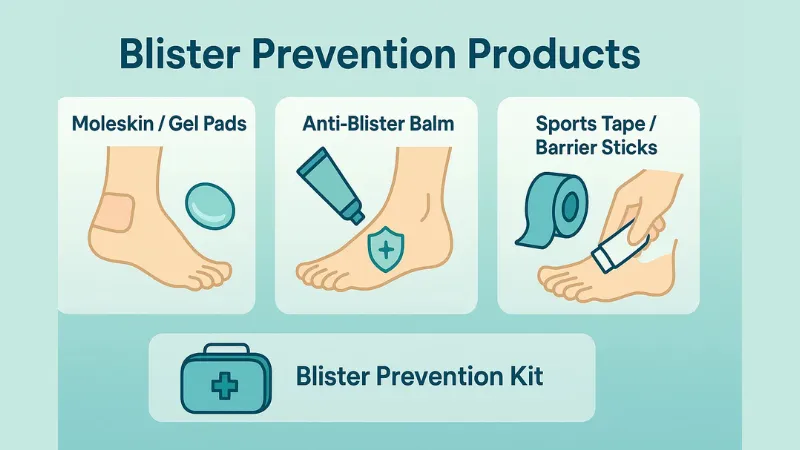
Anti-Blister Balms
These specialized balms work like an invisible layer of protection. Applied directly to your skin, they reduce friction, wick away moisture, and help keep your feet comfortable during long shifts. Many nurses keep a small tube in their pocket to reapply on breaks — especially during back-to-back shifts.
Sports Tape or Barrier Sticks
For days when you know your feet will take a beating, sports tape or barrier sticks provide extra reinforcement. They adhere well, even with sweat, and are ideal for high-friction areas or when breaking in new shoes.
By combining these products with a good nurse foot care routine, you can significantly lower your chances of developing painful blisters — even when standing or walking for 12+ hours.
Pro tip: Keep a small pouch in your locker or bag stocked with moleskin, balm, and a few gel pads so you can handle any hot spots before they turn into blisters.
Foot Stretches and Circulation Tips
When it comes to blister prevention, movement isn’t just for your back and legs — your feet need it too. Proper circulation helps reduce swelling, friction, and heat buildup, all of which can make blisters more likely.
1. Simple Stretch Breaks
- What: Gentle movements like toe curls, ankle rolls, and calf stretches.
- Why: These stretches keep muscles flexible, improve blood flow, and prevent stiffness.
- How: During your shift, take 30–60 seconds every couple of hours to roll your ankles in circles, flex and point your toes, or lean against a wall for a calf stretch.
2. Massage and Elevation
- What: Using your hands or a massage ball to knead the bottoms of your feet, then raising them above heart level.
- Why: This helps push fluid out of the feet and legs, reduces swelling, and speeds recovery after long hours.
- How: At the end of your shift, lie down, prop your feet on a pillow, and massage each foot for 2–3 minutes.
3. Preventing Swelling
- What: Consistently moving and elevating your feet to avoid fluid buildup.
- Why: Less swelling means less pressure and friction, which reduces blister risk.
- How: Combine stretching, massage, and compression socks to maintain healthy circulation all day.
Tip: Even small, regular movements matter — incorporating foot stretches for nurses into your daily routine can keep your feet healthier and your shifts more comfortable.
What to Do If You Already Have a Blister
Even with the most careful foot care routine, blisters can still sneak up on you — especially during back-to-back long shifts. Knowing how to handle them properly can mean the difference between quick healing and days of painful walking.
- Clean Gently
- What: Wash the blister and surrounding skin with mild soap and lukewarm water.
- Why: This removes bacteria and reduces the risk of infection.
- How: Pat dry with a clean towel — avoid rubbing, which can tear the skin.
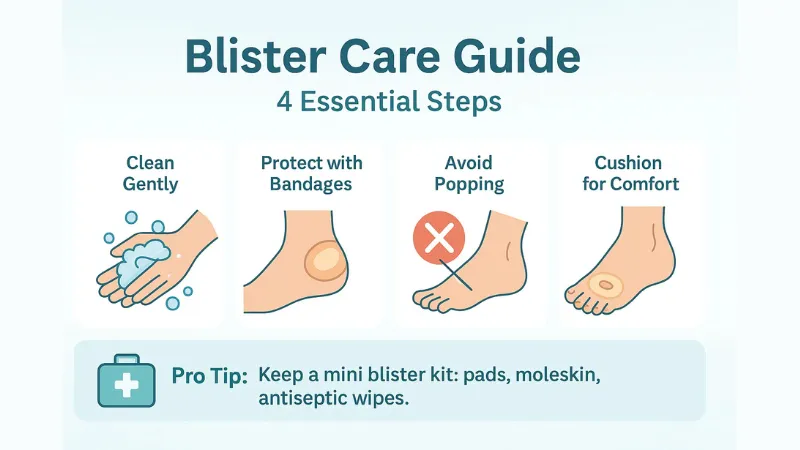
- Protect with Bandages
- What: Cover the blister with a blister-specific bandage, hydrocolloid dressing, or a piece of moleskin.
- Why: A protective layer prevents further friction and shields the area from dirt and bacteria.
- How: Make sure the bandage is snug but not tight, and replace it daily or if it gets wet.
- Avoid Popping
- What: Leave the blister intact whenever possible.
- Why: The fluid inside cushions the skin and speeds healing; popping too soon increases infection risk.
- How: If it’s too painful and needs draining, sterilize a needle with rubbing alcohol, pierce at the edge, and gently press out the fluid without removing the skin flap.
- Cushion for Comfort
- What: Use a “donut” pad or foam ring around the blister to reduce pressure.
Why: This allows you to keep moving without worsening the injury. - How: Place the pad so the blister sits in the center hole, then secure it with medical tape.
Pro Tip: Keep a mini blister care kit in your nursing bag — a few pads, moleskin, and antiseptic wipes can save your shift if a blister appears unexpectedly.
Recommended Products (Affiliate Links Section)
Consider these nurse-approved blister prevention essentials:
Products | |
Anti Blister Socks | |
Moleskin Pads | |
Gel Shoe Inserts | |
Cushioned Insoles | |
Foot Powder | |
Antiperspirants |
Conclusion
Blisters don’t have to be an unavoidable part of long shifts. By taking a proactive approach — wearing the best socks for standing all day, keeping moisture in check, choosing well-fitting shoes, and following a consistent nurse foot care routine — you can prevent blisters from standing for hours on end. Small daily habits, like quick foot stretches for nurses and checking for hot spots early, can save you from days of discomfort and keep you performing at your best.
Healthy feet aren’t just about comfort — they’re about protecting your mobility, energy, and career. Start making blister prevention part of your daily routine, and your future self will thank you.
FAQs
What are the best socks to prevent blisters from standing?
Moisture-wicking, seamless socks (like Merino wool or padded synthetic blends) are the best socks for standing all day.
How do I keep my feet from sweating in work shoes?
Use foot powders, antiperspirant sprays, and breathable footwear to minimize moisture.
Can foot stretches help reduce blisters?
Yes! Stretches improve circulation and reduce swelling, which lowers friction.
How do nurses take care of their feet after long shifts?
Nurses should clean, moisturize, and massage their feet daily, while rotating shoes and using cushioned socks.
What products help prevent blisters on your heels?
Moleskin, anti-blister balms, and cushioned heel pads are great preventive options.

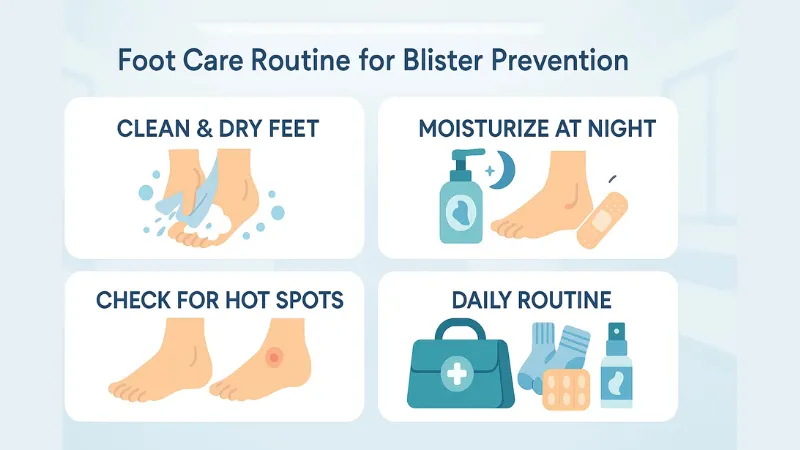
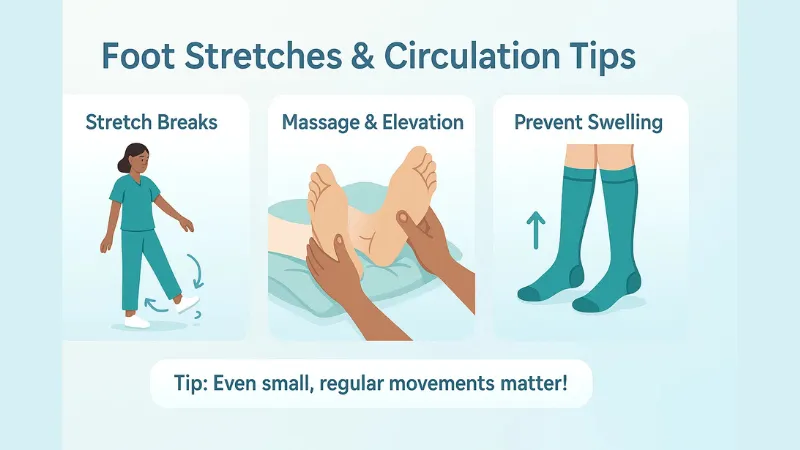
Leave a Reply